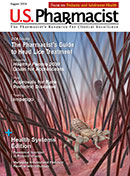Fluid stewardship involves promoting the appropriate use of fluids to prevent adverse outcomes. "Hidden fluids," which are defined as blood products, enteral nutrition, IV medications, diluents, and flushes, are often overlooked when calculating fluid requirements.
This is because these products' volumes are generally not specifically prescribed. Depending on the volume and frequency of administration of these "hidden fluids," they may contribute to fluid overload. This can lead to increased mortality and length of stay as well as other untoward adverse events, especially in the unstable ICU patient.
To more clearly characterize the contribution that individual IV medications have towards the fluid intake of critically ill patients, investigators conducted a multicenter, retrospective nested cohort study. This study took place in Georgia from January 2017 to December 2018 in the medical or surgical ICUs of a large academic medical center and two community hospitals.
For inclusion in the study, patients aged 18 years or older had to be admitted to a medical or surgical ICU and had to have an ICU length of stay of at least 4 days. Patients were excluded from the study if they were pregnant, received total parenteral nutrition, had end-stage renal stage disease or were receiving renal replacement therapy, had "do not resuscitate" or "do not intubate" orders, were transferred from another hospital, or had a specific indication for maintenance IV fluids (e.g., diabetic ketoacidosis, diabetes insipidus, cerebral salt wasting, a high-output fistula or high-output drain, tumor lysis syndrome, or rhabdomyolysis).
The primary outcome of this study was the volume of specific IV medications administered over the first ICU doses. The cumulative mean volume was the mean of the total volume captured per patient over the first 3 ICU days. The secondary outcome included the frequency of specific IV medications (i.e., the proportion of patients who received each medication and the proportion of total fluid intake made up by IV medications over the first 3 ICU days).
The fluid data were collected daily over the first 3-day calendar ICU days from the time of admission; however, the volume of fluids administered on previous floors or in the emergency department were excluded. Complete fluid sources consisted of fluids from resuscitation, maintenance, and hidden fluids.
The investigators analyzed data from 210 patients (mean age: 62 years) who were primarily admitted to the medical ICU (95%). Almost one-half (47%) had congestive heart failure, a condition in which fluid overload can contribute to significant morbidity. The IV medications with the largest cumulative mean volumes and highest administration frequencies over the first 3 days of ICU admission included antibacterial agents (mean volume of 968 mL with an administration frequency of 180), vitamins/minerals/electrolytes (mean volume of 416 mL with an administration frequency of 123), medications for pain/agitation/delirium (mean volume of 310 mL with an administration frequency of 143), and vasoactive agents (which included antihypertensive agents; mean volume of 282 mL with an administration frequency of 96). "Hidden fluids" accounted for 56% of the fluid intake per patient over the course of the first 3 ICU days. This corresponded with a mean volume of 3,629 mL.
Pharmacists can play a major role in fluid stewardship. Since antibacterial agents had the highest volume and administration frequency, when appropriate, pharmacists can promote the de-escalation of broad-spectrum IV antibiotics, switching to oral agents or implementing extended or continuous infusions. They can educate providers and encourage the incorporation of hidden fluids into the calculations of fluid balance. Maintenance and resuscitation fluids can be adjusted taking these hidden fluids into account. Other strategies that can be recommended to reduce fluid volume are the use of IV push as allowed and discontinuing unused IV orders.
The content contained in this article is for informational purposes only. The content is not intended to be a substitute for professional advice. Reliance on any information provided in this article is solely at your own risk.
« Click here to return to Infusion Pharmacy Update.






